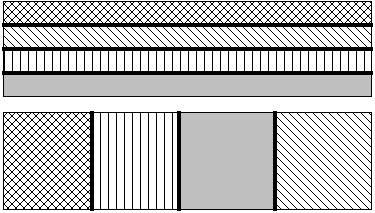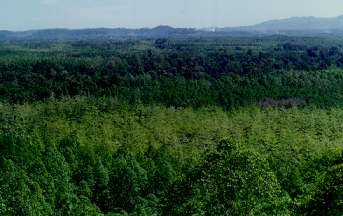Preventive
Measures
go to main menu
This article is divided into the following sections:
- Monoculture versus
Polyculture
- Cultural
Diversification
- Prevention or Cure?
- Preventive Measures in
Forestry
Monoculture versus
Polyculture
In the above example the termites attacking tree crops in a
plantation are considered as a pest. In fact the termites are not
a pest per se, but the conditions in the plantation are
suitable for the termites to multiply and to cause damage to the
tree crops and therefore man judges the termites to be a pest.
Actually man is responsible for an insect becoming a pest,
because man creates artificial conditions unsuitable for the crop
and suitable for a pest.
A cultural system with only one particular crop species,
called monoculture, is far more susceptible to insect
attack than natural systems. The plants in a monoculture are
often weakened and their natural resistance is decreased because
there is high competition between the plants for nutrients,
light, water, etc. Additionally, because of the low diversity in
a monoculture there are hardly any suitable conditions for
enemies that control a pest in a natural way. Furthermore, the
source of food for a particular pest is abundant in a
monoculture. This condition is most favourable for a pest to
multiply rapidly, because the availability of food is the most
important limiting factor for the growth of insect populations.
Finally, a monoculture is not only reduced in terms of the number
of species but also in terms of age classes since all plants are
the same age. This is important because many pests attack their
host only at a particular age. For instance only four to eleven
year old Hoop pines are attacked by Hylurdrectonus araucariae.
If all trees belong to the same age class, all of them will quite
likely become the target of a pest attack.
In contrast, a polycultural system has a higher
diversity of planted crops. As a result there is less competition
between the different species due to the different requirements
of each species. Furthermore, the food plant of a particular pest
is less abundant and might be dispersed, occurring only here and
there so that it is more difficult for the pest to locate its
host. Due to the species diversity in a polyculture there is a
variety of predators and parasites that help to control the pest
naturally. Therefore, a polyculture is usually less susceptible
to insect pests.
Cultural Diversification
Agriculturalists often benefit from the advantage of a more
diverse system like a polyculture in terms of pest
susceptibility. In large-scale forestry however, it is a bit more
complex since the planted species ideally require the same time
from planting to harvesting so that the whole plantation can be
clear-felled. Furthermore, particular crop species might suppress
the growth of an adjacent species. A diversification of a
monoculture can be gained, for instance by planting small but
long strips of different crops next to each other as shown below.
The diversity is usually higher in the transition zone (ecotone)
between two different habitats or compartments with different
crops. Higher species diversity in general contributes towards
the increased natural resistance of the crops as well as higher
numbers of natural enemies. The diversification by means of age
classes, can further help to increase plant resistance and
decrease the susceptibility to pest infestation. These
considerations are a basic concept of pest control and should be
part of the planning and establishment of plantations.


Diversification of Cultural
Systems: small strips of Kamarere in the foreground
followed by Erima, Talis and secondary forest in the background
at the Stettin Bay Lumber Company reforestation area near Kimbe,
West New Britain; this setup has more diverse ecotones indicated
by thick black lines (upper drawing) than the theoretical setup
shown in the bottom drawing
Prevention or Cure?
In the ancient Greek society physicians were paid for
maintaining their patient’s health, the doctors’ job
was to prevent illnesses. Once a patient became sick the doctor
was sacked because he apparently failed to do his job properly.
The contemporary ‘Western’ health concept is different
or even contrary. We visit the Haus Sik when we feel ill
and most physicians do little to prevent their patients from
becoming sick. Since plants are living creatures,
agriculturalists and foresters have the obligation to attempt to
maintain our crops in a healthy condition and to prevent
diseases. The nursery, garden and plantation should be a Health
Centre rather than a Haus Sik. The prevention of diseases
is the key to the successful cultivation of crops. Prevention is
often more effective, cheaper, environmentally more sound and
more appropriate than curative measures. In forestry there are
hardly any effective curative measures available and therefore in
most cases there is no other choice apart form preventive
measures. Regular monitoring is also of great importance so that
disorders can be recognised at an early stage and curative
measures can be taken if necessary.
Preventive Measures in
Forestry
This section outlines possible preventive measures to minimise
the risk of pest infestation. The measures are recommended by the
Forest Research Institute (FRI) as well as by
experienced senior foresters and apply to any tree species.
- Site preparation: Termite-infested tree stumps
should be removed immediately after clear felling if
replanting is intended. Therefore the logged site should
be searched for subterranean nests before the area
disappears in tall kunai grass. Infested stumps
can be easily found since they often have a hollow
‘pipe’. Ideally the infested stumps are
uprooted, an exercise which is very difficult. Even a
bulldozer has difficulty pulling out the stump of a newly
felled tree. Previously explosives, injected below the
stump and ignited were used for that purpose. The
explosives were prepared from a mixture of diesel and
ammonium nitrate, contained in fertiliser. The problem
with this method was the availability of experts for the
safe handling of the explosives. In addition waste wood
that would offer additional food for the termites should
be removed. Finally it is recommended that compacted soil
be broken up prior to replanting.
- Nursery: The right species and provenance suiting
the soil type and climatic conditions in the proposed
area, and only high quality seed material should be used.
The seedlings should be kept in the nursery until they
are large and vigorous enough to be planted to the field.
How long they are kept in the nursery involves a
compromise of several factors. If the seedlings are kept
in the nursery for a longer time, the bark will be thick
enough and will be no longer a suitable source of food
for grasshoppers. Furthermore the mortality rate of the
seedlings will be lower. On the other hand, the tap root
will quite likely start to coil and this will encourage
termite attack. Additionally, each day in the nursery
costs money to carry out watering and weeding of the
seedlings.
- Planting: Only healthy and vigorous seedlings
should be used. Wider spacing should be taken into
consideration since less refilling, tending and thinning
has to be done. Apart from reducing the costs of these
operations, a wider spacing results in faster growing
trees because of less competition and a reduction in the
potential damage done to the trees during each of these
operations. The tubed seedlings are not supposed to be
exposed to the heat of the sun but should be placed
somewhere in the shade. The temperatures under the black
polythene can be as hot as 80° C, enough to cook the
roots of a seedling. The tube has to be removed prior to
planting. A suitable plant hole has to be dug, big enough
to allow all roots to fit in. The coiled taproot of the
seedling should be uncoiled, otherwise it will strangle
itself as it increases in diameter. Many uprooted
termite-infested seedlings show a coiled and already
deteriorated tap root, through which termites started the
infestation. Therefore, coiling and upwards bending of
the roots should be avoided during planting, so that the
root system can develop properly. Planting should be
carried out in such a way that the newly planted
seedlings suffer as little stress as possible. Some water
and fertiliser if necessary will give the seedling the
right start.
- Tending and Pruning: Any damage of the bark during
pruning should be avoided. The branches are supposed to
be pruned as close to the stem as possible, so that the
bark grows over the sore immediately (rapid occlusion).
Diversity should be allowed in a plantation rather than
creating a monoculture. A diverse understorey offers
attractive conditions for beneficial insects. Hygiene in
the plantation is of great importance. Pest-related
problems are often enhanced because waste such as pruned
branches offers additional food for pests. One should
consider removal or burning of any waste. Furthermore,
silvicultural treatments such as tending and pruning
should not be delayed but carried out as early as
possible.
- Thinning: Damage of the bark of residual trees
caused by falling trees should be avoided. Only
experienced chainsaw operators familiar with directional
felling should carry out the operation. Vehicles like
skidders should only be operated, if really necessary so
that soil compaction and damage of rootlets of trees
along the snig tracks are minimised. The use of bandages,
eg. made from the rubber of a worn-out conveyor belt
should be considered in order to protect the base of the
stem from being damaged by wheels. It is doubtful whether
waste wood placed at the base of the trunk can protect
the roots from being damaged by skidders. In other
countries skidders are more and more being replaced by
horses for hauling. Horses are much cheaper than a
skidder and do less harm and damage to trees. Straight
snig tracks can also contribute towards less damage of
residual trees because damage often occurs in bends. It
is advisable to leave a buffer of trees along the snig
tracks which are felled at the end of the operation. Any
gravel piled up for the construction of temporary roads
has to be removed after the operations. If gravel is
covering the bark of trees along the road, it will cause
rot and damage of the trees in the long term. Waste
materials such as timber or gravel should not be pushed
downhill but disposed of thoroughly. Bigger pieces of
timber or boulders can easily damage the bark of trees
when rolling downhill. The right season for thinning, and
also for pruning should be considered. Most wood-boring
insects attack only green timber and as the timber dries,
it becomes less suitable for an attack. Therefore fewer
problems are experienced when thinning is carried out
during the dry season, when the waste dries faster.
- Post Logging: The harvested timber should be
removed from the forest as soon as possible to avoid
infestation with wood borers resulting in timber degrade.
Ideally the timber should be immediately processed after
harvesting. If this is not possible, the entire log
surface has to be treated with a suitable insecticide or
the stems have to be continuously sprinkled with water.
Another preventive measure that should be considered in
some cases is to debark the logs in order to create
conditions that are no longer suitable for insects
associated with the bark and the sapwood.
- Regular Visits: During regular visits of the
plantation, any signs of an insect attack should be
thoroughly monitored. The earlier an outbreak is
detected, the more successfully remedial measures can be
taken and the smaller the economic loss will be.
- Other Silvicultural Practices include the
diversification of single-species forests and the
diversification of age classes as discussed in the
previous section. The elimination of alternative or wild
hosts is a further possibility to prevent insect-related
problems. An example is the elimination of Lau-lau (Syzygium
spp.), the wild host of Agrilus spp., adjacent
to areas where Eucalyptus deglupta or Terminalia
spp. plantations are established
go to main menu
go to forest fire
© Michael F. Schneider,
1999



